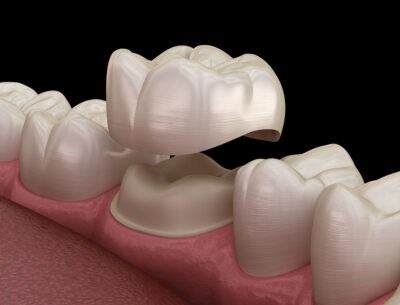
Patients often have to decide between a crown vs. veneer treatment when it comes to both cosmetic and dental health concerns due to crooked or chipped teeth, damaged teeth, or discoloration.
Both dental restoration procedures have their own suite of benefits and may result in a noticeable cosmetic improvement to your smile. However, these dental procedures also have considerations that patients must consider before moving forward.
For example, while cosmetic veneers can create a brilliant difference in the front surface of multiple teeth, they may not provide a long-term solution for decayed teeth, severely chipped teeth, or other oral health issues. Dental crowns, however, are often recommended as a restorative treatment for multiple dental problems. These issues include cosmetic purposes, as a crown covers the entire tooth structure, adding an extra layer of protection.
Again, either of these cosmetic procedures will result in a natural-looking smile, and our dental clinic team can guide you in choosing the best option for your unique oral health needs: dental veneers or crowns. What’s the difference? Read on to learn more about dental veneers vs dental crowns and get a jump start on understating which cosmetic dentistry option is best for your smile and your health.
Table of Contents
What is the Procedure for Porcelain Veneers?
What is a Dental Crown?
Types of Dental Crowns
Veneers vs Crowns – The Pros and Cons
Understanding the Differences Between Veneers and Crowns
Porcelain Veneers and/or Composite Veneers
What is a Porcelain Veneer?
Dental veneers or porcelain veneers cover only the front surface of a tooth instead of the whole tooth. Usually (and as needed), these thin porcelain veneers are applied in sets of six or eight, depending on the width of your smile. As the name suggests, porcelain veneers consist of a thin layer of porcelain or composite material applied to natural teeth to enhance your cosmetic appearance.
A popular procedure in cosmetic dentistry, porcelain veneers or composite veneers can be used to cover stains, mildly chipped teeth, slight gaps in your front teeth, and crooked teeth. They can essentially make every and any tooth surface match your natural teeth.
What is the Procedure for Porcelain Veneers?
Veneers and crowns are typically two-step procedures that require more than one trip to the dentist’s office.
For porcelain veneers, your cosmetic dentist will remove a thin layer (roughly half a millimeter) of the front tooth enamel to roughen the surface for the bonding of the porcelain veneer. During this time, impressions of your front teeth will also be made in order to create porcelain veneers or composite veneers.
Your cosmetic dentist may recommend that you wear a temporary veneer, depending on how much tooth enamel was removed from the prepared tooth or teeth. When your porcelain veneers or composite veneers are ready, your cosmetic dentist will then apply a thin layer of a bonding agent to the tooth structure and add the veneers, resulting instantly in a brilliant new smile.
When are Porcelain Veneers Recommended?
Porcelain veneers or composite veneers are optimal for cosmetic purposes. They can fix the appearance of teeth that are damaged or discolored from root canal treatment, stains from tetracycline or other drugs, or even excessive fluoride. While cosmetic porcelain veneers are often not covered by dental insurance, they are an inexpensive treatment that ensures your healthy natural tooth remains intact.
Since veneers consist of a thin layer of porcelain that is applied to the front teeth, they are not an effective treatment for issues in your existing teeth, including:
- weak tooth
- broken tooth
- damaged tooth
- problems due to tooth decay
- teeth grinding
- poor dental hygiene
- or other concerns
When it comes to veneers vs. crowns, porcelain veneers or composite veneers are a great way to brighten a healthy natural tooth. On the other hand, dental crowns are a better fit to restore damaged teeth.
Dental Crowns
What is a Dental Crown?
A dental crown is a tooth-shaped cap placed over the entire tooth to improve the appearance of the natural tooth or natural teeth. Since the dental crown covers the entire tooth, it effectively fully encases the entire visible portion of a tooth that lies at and above the gum line or gum margin.
As a result, a dental crown or multiple dental crowns can be a great cosmetic solution for several more noticeable issues that may affect the entire existing tooth, such as tooth decay, cracks, discoloration from root canals, smoking, or other dental hygiene issues.
Both veneers and crowns can enhance your cosmetic appearance, but a dental crown has additional benefits. A dental crown protects a weak natural tooth from breaking or support an existing tooth from further deterioration. Dental crowns can also hold dental bridges and dental implants in place, cover dental implants, or cover severely misshapen teeth.
What is the Procedure for Dental Crowns?
As stated, veneers and crowns often require more than one trip to the dentist’s office, as the crowns must be custom-built for your natural teeth before crown placement can commence.
On the first trip to the dentist’s office, your dentist will make an impression of your natural tooth or teeth by digitally scanning it or making mold, like veneers. Your dentist will also likely examine your existing teeth to see if there is extensive decay or a risk of infection or treatment. Therefore, your dentists might recommend a root canal procedure, which is required first.
Since the dental crowns are constructed, your dentist will reshape the tooth around the chewing surface and the sides to make room for the crown cap to be added. Anesthesia may be used to minimize any gum pain during this stage in the process.
After that, the dentist may recommend wearing a temporary crown before your permanent crown is created. Furthermore, the permanent crown will be added at the second visit, and your crowned tooth or teeth will look exactly like your natural teeth when you leave the dentist’s office.
Types of Dental Drowns
Dental technicians can create different types of dental crowns from varying crown materials, and the type that is best for you depends on your preferences and your oral health needs.
Metal Crowns
Metal crowns generally consist of a metal alloy of various materials, like gold, palladium, nickel, and chromium. These metal alloy crowns are resistant to chips or brakes, last a long time, and only require a small amount of tooth enamel removal. They can withstand the toughest biting and chewing forces, and the main drawback of these metal alloy crowns is the color. As such, they are a better fit for out-of-sight teeth as opposed to front teeth, like back molars.
All-ceramic Crowns or Porcelain Crowns
Porcelain and ceramic crowns mimic the appearance of tooth enamel more than any other crown type and are also a good fit for patients who may have allergies to metal. Although porcelain and ceramic crowns may not be as tough as metal crowns, these brilliant white options are great crown covers for front teeth and other visible teeth.
Other Crown Options
Other options for a crown cover include pressed ceramic crowns, porcelain-fused-to metal crowns, same-day dental crowns, and more. Talk to your dentist about your options, and together, you can make an informed decision on the best type of dental crown for your smile.
When are Dental Crowns Recommended?
Dental crowns are best suited for patients with discoloration or damage to an entire tooth or who need better treatment for an existing tooth with more severe damage. While both veneers and crowns can enhance your appearance, veneers are for cosmetic purposes only, while crowns can strengthen and support a damaged natural tooth. Crowns may also be covered by dental insurance, especially if they are being used to enhance an existing tooth and are not just being recommended for cosmetic enhancement alone. Both veneers and crowns keep most of the original tooth intact, although some reshaping may be needed to make room for the crown covers.
Veneers vs. Crowns – The Pros and Cons
When it comes to veneers vs. crowns, it’s helpful to understand the advantages and disadvantages of veneers and crowns to determine which is the best option for you going forward.
The Pros of Veneers
Let’s discover the following advantages that apply to veneers.
- Veneers require less filling than crowns, so more of your natural tooth or existing tooth is saved during the procedure.
- Veneers may be more aesthetically beneficial since they do not show any margin in the gum line after a few years due to their direct application to the tooth enamel.
- Veneers may be a shorter and more comfortable process, as crowns may require additional procedures like a root canal before the natural tooth can be shaped for the dental crown.
Veneers vs. Crowns – The Cons of Veneers
Patients will also want to consider the possible disadvantages that may apply to veneers
- Veneers are not reversible and are permanently in place
- Some composite veneers may be less expensive but have a shorter lifespan of 5-7 years. Other types of veneers can last years longer but may have to be replaced eventually.
- Veneers only cover a section of the tooth surface or tooth enamel, so the rest of the natural tooth may still be subject to tooth decay.
- Veneers are a cosmetic treatment, so they may not be covered by dental insurance.
The Pros of Dental Crowns
Dental crowns have their distinctive suite of benefits, which include the following.
- Porcelain crowns look and feel exactly like a natural tooth and function the same way as your existing teeth.
- Dental crowns cover all the tooth surface, which ensures your natural tooth is protected from tooth decay.
- Crowns are permanent and do not have to be removed for cleaning and other oral hygiene measures, like dentures.
- Crowns may be covered by dental insurance, depending on the reasons behind the crown procedure.
Veneers vs. Crowns – The Cons of Dental Crowns
Here are the possible drawbacks of dental crowns in the veneers Vs. dental crowns debate
- Dental crowns can be a lengthier procedure as the tooth needs to be reshaped to make room for the crown covers.
- Some types of crowns, like porcelain crowns, may be fragile and can break over time.
- Other types of crowns, like Porcelain fused to a metal alloy (PFM) crown, may show a thin dark line between the crown and the natural tooth.
- Your newly crowned tooth may be extra sensitive to hot and cold temperatures, and there may be some gum pain after the procedure.
- You may require additional procedures to get your natural tooth ready for the crown placement, such as a root canal.
Veneers and Crowns – The Similarities
- Both crowns and veneers will lead to a brighter, more beautiful smile, as these procedures enhance your natural teeth.
- Veneers and crowns typically require more than one trip to the dentist, and you may need a temporary crown to temporary veneer if re-shaping or preparing your teeth has left a tooth exposed
- Veneers and crowns are generally inexpensive and are minimally invasive procedures.
- Both crowns and veneers last for years – if not forever – and can be a permanent solution to a discolored or otherwise imperfect smile.
Understanding of the Differences Between Veneers and Crowns
When it comes to veneers vs. crowns, the best way to decide is to start with expert guidance, and this is where Pannu dental Group can help.
Our client-focused team wants to ensure you have the most comfortable experience and the most exceptional results possible. In addition, we utilize the latest advancements in medical technology to assist both crown and veneer procedures every step of the way.
Reach out to us today to schedule an initial consultation. We’ll work with you to identify the best distinctive way to restore your smile and your oral health. With Pannu Dental Group guiding the way, you can enjoy a brilliantly restored smile that looks and feels like your natural teeth, and which will supply you with years of confidence and great oral health.
Looking for a Cosmetic Dentist near Cupertino?
If you’re searching for a cosmetic dentist near San Jose, our practice is conveniently located and offers a wide range of cosmetic dental services. As a leading cosmetic dentist in San Jose, we take pride in helping patients achieve their desired smile through personalized treatment plans. We also have several locations, including a cosmetic dentist near Cupertino. We welcome patients from the surrounding communities and always provide exceptional care. Take the first step towards a fantastic smile.
Contact us today to schedule a consultation.
Dr. Dalvir S. Pannu has been a practicing dentist since 1995. In 1996 he opened his first dental practice in India, where he gained invaluable experience and acumen. In October of 1997 he was invited by the American Dental Association (ADA) to present the table clinic on Endodontics, at their annual session held in Washington, D.C. At this time he fell in love with the United States and became passionate about practicing dentistry in California. He became particularly enamored of the San Francisco Bay area, and soon took up residence and work here.







